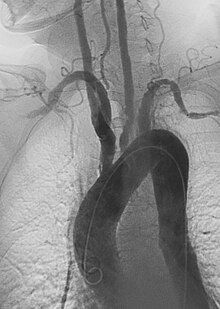Introduction
 |
| Image credit |
Understanding Takayasu’s Arteritis
Takayasu's arteritis (TA) is a rare chronic inflammatory disease that affects large blood arteries, mainly the aorta and its branches. Although it can happen to anybody, it generally affects young women, particularly those of Asian heritage. It often referred to as the "pulse-less disease" because of its defining characteristic, which is weak or absence of pulses.
The Enigma of Its Cause
The cause of Takayasu's arteritis is uncertain. But according to researchers, it's an autoimmune reaction in which the body's arteries are wrongly attacked by the immune system. Its onset may also be influenced by environmental stimuli and genetic variables.
 |
| Left anterior oblique angiographic image of Takayasu's arteritis showing areas of stenosis in multiple great vessels Image Credit |
Recognizing the Symptoms
Early symptoms of TA are often vague, making diagnosis a challenge. These may include:
Fatigue
Fever
Unexplained weight loss
Joint pain
As the condition progresses, reduced blood flow leads to more distinct symptoms:
Weak or absent pulses
High blood pressure
Pain or cramping in arms or legs during activity
Dizziness or fainting
Visual disturbances
Diagnosing Takayasu’s Arteritis
Given its rarity, diagnosing TA requires thorough investigation. Physicians typically use:
Imaging Tests: MRI, CT scans, or angiography to identify arterial inflammation or narrowing.
Blood Tests: To detect inflammatory markers like C-reactive protein (CRP) or erythrocyte sedimentation rate (ESR).
Image Credit
Treatment Options
While there is no cure for Takayasu’s arteritis, treatments aim to manage inflammation and prevent complications. Key approaches include:
Corticosteroids: These provide rapid relief from inflammation.
Immunosuppressants: Medications like methotrexate or azathioprine help sustain long-term control.
Biologic Therapies: Drugs such as tocilizumab target specific inflammatory pathways for better management.
Surgical Solutions: In cases of severe arterial damage, procedures like bypass surgery or stent placement may be necessary.
Thriving with Takayasu’s Arteritis
Adapting to life with TA involves embracing new routines and priorities. Here are strategies to thrive:
Educate Yourself: To speak up for your health and make educated decisions, educate yourself about the disease you have.
Seek Support: Join support groups or online communities to connect with others who understand your journey.
Practice Self-Care: Focus on adequate rest, balanced nutrition, and appropriate physical activity to boost your overall well-being.
Monitor Regularly: Keep track of your blood pressure and schedule routine medical check-ups.
Conclusion
Living with Takayasu’s arteritis poses unique challenges, but it also fosters resilience and adaptability. By staying informed, building a support network, and working closely with healthcare professionals, individuals can lead meaningful lives beyond their diagnosis. Whether you are a patient, caregiver, or curious reader, understanding this rare condition paves the way for empathy and progress.

.jpeg)

No comments:
Post a Comment